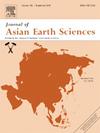孟德勒斯地块早中新世埃达质花岗岩的岩石成因及其构造意义
IF 2.7
3区 地球科学
Q2 GEOSCIENCES, MULTIDISCIPLINARY
引用次数: 0
摘要
Menderes地块是本文章由计算机程序翻译,如有差异,请以英文原文为准。

Petrogenesis and tectonic implications of Early Miocene adakitic granites in the Menderes Massif (western Türkiye)
The Menderes Massif, a significant Alpide metamorphic complex in Türkiye, is recognized as one of the most extensively studied core complexes globally, characterized by syn-extensional intrusions with diverse geochemical characteristics. Among these is the Güneşli granite, located in the northern Gördes submassif, which intrudes the basement migmatites. This study presents the petrography, geochemistry, Sr-Nd isotope compositions, and U-Pb zircon dating of the Güneşli granite. The intrusion consists of monzogranite, granodiorite and a late-stage pegmatite. Granodiorite is located in the core zone, while monzogranite contacts migmatites. Textures and contact relationships suggest shallow emplacement. U-Pb zircon dating yields an Early Miocene age of 22.3 ± 1.2 Ma. Geochemically, the Güneşli granite has high SiO2 (>71.6 wt%) and is slightly peraluminous (ASI = 1.0–1.1), classifying it as I-type granite. It shows calc-alkaline to high-K calc-alkaline affinities. Source characteristics indicate high-K mafic rocks to tonalite. The high Sr/Y (avg 47.5 ppm) and LaN/YbN (avg 32.4 ppm) ratios, and Eu/Eu* (0.8 to 1.4), suggest an adakitic signature. Its potassic nature (K2O/Na2O > 0.5) and low MgO content suggest derivation from lower crustal depths rather than slab melting. Additionally, high DyN/YbN and LaN/YbN ratios indicate garnet presence in the source. The 87Sr/86Sr and εNd values range from 0.709275 to 0.712199 and from −10.6 to −7.3, suggesting the possibility of upper crustal assimilation during crystallization. The Güneşli granite was likely derived from deep crustal sections of the Menderes Massif during the Aegean extensional period, coinciding with Early Miocene core complex exhumations.
求助全文
通过发布文献求助,成功后即可免费获取论文全文。
去求助
来源期刊

Journal of Asian Earth Sciences
地学-地球科学综合
CiteScore
5.90
自引率
10.00%
发文量
324
审稿时长
71 days
期刊介绍:
Journal of Asian Earth Sciences has an open access mirror journal Journal of Asian Earth Sciences: X, sharing the same aims and scope, editorial team, submission system and rigorous peer review.
The Journal of Asian Earth Sciences is an international interdisciplinary journal devoted to all aspects of research related to the solid Earth Sciences of Asia. The Journal publishes high quality, peer-reviewed scientific papers on the regional geology, tectonics, geochemistry and geophysics of Asia. It will be devoted primarily to research papers but short communications relating to new developments of broad interest, reviews and book reviews will also be included. Papers must have international appeal and should present work of more than local significance.
The scope includes deep processes of the Asian continent and its adjacent oceans; seismology and earthquakes; orogeny, magmatism, metamorphism and volcanism; growth, deformation and destruction of the Asian crust; crust-mantle interaction; evolution of life (early life, biostratigraphy, biogeography and mass-extinction); fluids, fluxes and reservoirs of mineral and energy resources; surface processes (weathering, erosion, transport and deposition of sediments) and resulting geomorphology; and the response of the Earth to global climate change as viewed within the Asian continent and surrounding oceans.
 求助内容:
求助内容: 应助结果提醒方式:
应助结果提醒方式:


